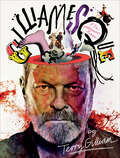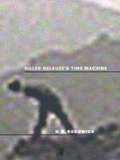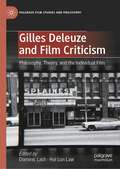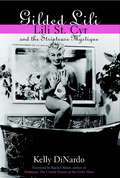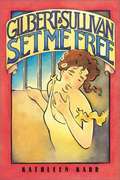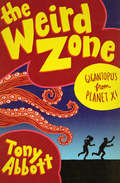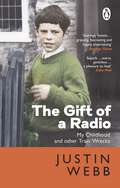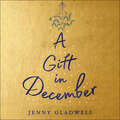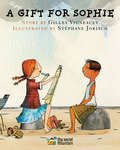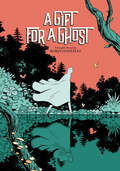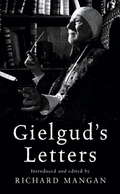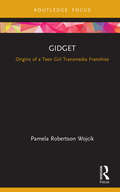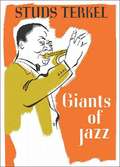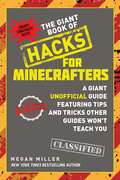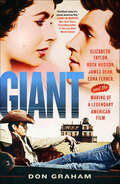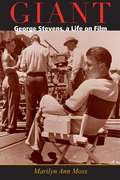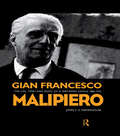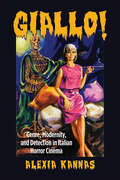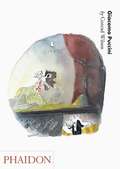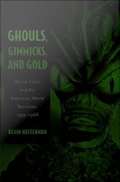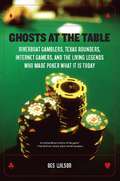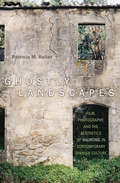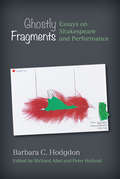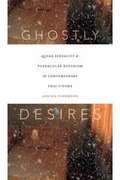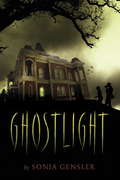- Table View
- List View
Gilliamesque: A Pre-posthumous Memoir
by Terry GilliamThe screenwriter, innovative animator, highly acclaimed visionary film director, and only non-British member of Monty Python offers an intimate glimpse into his world in this fascinating memoir illustrated with hand-drawn sketches, notes, and memorabilia from his personal archive.From his no-frills childhood in the icy wastes of Minnesota, to some of the hottest water Hollywood had to offer, via the cutting edge of 1960s and ’70s counter-culture in New York, L.A. and London, Terry Gilliam’s life has been as vivid, entertaining and unorthodox as one of his films.Telling his story for the first time, the director of Time Bandits, Brazil, The Adventures of Baron Munchausen, The Fisher King, 12 Monkeys, and Fear & Loathing in Las Vegas—not to mention co-founder of Monty Python’s Flying Circus—recalls his life so far. Packed with never-before-seen artwork, photographs and commentary, Gilliamesque blends the visual and the verbal with scabrous wit and fascinating insight.Gilliam’s “pre-posthumous memoir” also features a cast of amazing supporting characters—George Harrison, Robin Williams, Jeff Bridges, Robert De Niro, Brad Pitt, Uma Thurman, Johnny Depp, Heath Ledger and all of the fellow Pythons—as well as cameo appearances from some of the heaviest cultural hitters of modern times, from Woody Allen to Frank Zappa, Gloria Steinem to Robert Crumb, Richard Nixon to Hunter S. Thompson. Gilliam’s encounters with the great and the not-so-good are revealing, funny, and hugely entertaining.This book is an unrestrained look into a unique creative mind and an incomparable portrait of late twentieth-century popular culture.
Gilles Deleuze’s Time Machine
by David RodowickAlthough Gilles Deleuze is one of France's most celebrated twentieth-century philosophers, his theories of cinema have largely been ignored by American scholars. Film theorist D. N. Rodowick fills this gap by presenting the first comprehensive study, in any language, of Deleuze's work on film and images. Placing Deleuze's two books on cinema--The Movement-Image and The Time-Image--in the context of French cultural theory of the 1960s and 1970s, Rodowick examines the logic of Deleuze's theories and the relationship of these theories to his influential philosophy of difference.Rodowick illuminates the connections between Deleuze's writings on visual and scientific texts and describes the formal logic of his theory of images and signs. Revealing how Deleuzian views on film speak to the broader network of philosophical problems addressed in Deleuze's other books--including his influential work with Félix Guattari--Rodowick shows not only how Deleuze modifies the dominant traditions of film theory, but also how the study of cinema is central to the project of modern philosophy.
Gilles Deleuze and Film Criticism: Philosophy, Theory, and the Individual Film (Palgrave Film Studies and Philosophy)
by Dominic Lash Hoi Lun LawThis book is the first collection of essays to offer detailed examinations of the role that close attention to individual films plays in the philosopher Gilles Deleuze’s work on cinema. In the last two decades, Deleuze's two books on film have had an enormous influence on Film Studies, profoundly affecting thinking about movement, time, history, and other topics. Theoretically ambitious and philosophically rich but clearly written by a broad range of established and emerging international film scholars, the chapters in this volume will both contribute to, and in places challenge, the vibrant field of Deleuzian film studies. Topics covered range from the relationship of Deleuze to film criticism; the role of theories of movement; and studies of works by major filmmakers including Federico Fellini, Werner Herzog, Vincente Minnelli, and Orson Welles. This book will be of interest not only to specialists in Deleuze but to anybody engaged with the close study of film and its philosophical ramifications.
Gilded Lili
by Kelly DinardoBlond and beautiful, Lili St. Cyr shimmied across the country's nightclubs as one of the century's great sirens. She inspired future femme fatales including Marilyn Monroe, Madonna and Dita Von Teese. She helped cultivate the modern-day impression of striptease. And, with stage routines featuring themes from fantasy, history and literature, she scandalized and seduced millions, influencing pop culture for decades.Gilded Lili: Lili St. Cyr and the Striptease Mystique explores the life of the last real queen of burlesque. Born into a poor family, abandoned by her parents, and raised by her grandmother, she used her ambition, beauty, and charm to escape her small-town life. Upon becoming the top burlesque dancer of her era, she amassed legions of famous fans, including Betty Grable, Frank Sinatra, Ronald Reagan, and Humphrey Bogart. During her reign, one reporter called her "the rich man's Gypsy Rose Lee" and Marilyn Monroe took cues from her acts. After she retired, Mike Wallace wrote that his television interview with her remained one of the most fascinating he had ever conducted.The private Lili was considerably more troubled, however. Despite being married six times, Lili found love elusive; she was involved in affairs with wealthy businessmen and rumored to have dalliances with celebrities including Orson Welles, Victor Mature and Yul Brynner. She had as many as ten abortions, attempted suicide several times, and became reliant on sleeping pills and, ultimately, heroin.A searing look at American sexuality in the twentieth century, Gilded Lili immortalizes the legend with verve and grace. Lili's era - which see-sawed between McCarthyism and puritanical humor - is presented with vibrancy, intelligence, and commentary on the ever-changing dynamics between sex and commerce. Based on exhaustive research and filled with rare photographs, Gilded Lili reveals a portrait of a woman who made the century sizzle.
Gilbert and Sullivan Set Me Free
by Kathleen KarrIn prison, there are few secrets. But Libby Dodge, the youngest inmate, guards the nature of her crime from the other women, even as they openly recount their former lives as arsonists, thieves, and prostitutes.
Gigantopus from Planet X! (The Weird Zone #6)
by Tony AbbottHumongous Studios makes the weirdest horror movies ever, and in its next film, the monster is a real-life threat! Sean and Holly&’s dad owns the wackiest business in Grover&’s Mill: a horror filmmaking studio. For his newest movie, their dad has decided to feature a gigantic robot octopus as the star of the show. When Holly and Sean visit the studio with their friends, they are excited to get a first-hand look at how movies are made. Unfortunately, there is one problem: Gigantopus is completely out of control, and its alien master plans to use the star to take Grover&’s Mill back to her home planet!In a fight fit for the big screen, Holly and Sean must battle Gigantopus and save their town from being sucked into space. This may turn out to be their dad&’s oddest movie yet!
The Gift of a Radio: My Childhood and other Train Wrecks
by Justin Webb'Searingly honest... gripping... fascinating and hugely entertaining.'- Sunday Times'Moving and frank ... A story of a childhood defined by loneliness, the absence of a father and the grim experience of a Quaker boarding school. It is also one of the most perceptive accounts of Britain in the 1970s.'- Misha Glenny'A crisp, unself-pitying memoir of a 'trainwreck' youth ... I've always likes Webb on the radio. But I like him much more after reading this book. He offers precisely the kind of brisk honesty and considered analysis he expects from his interviewees. Our politicians should all read it, and step up their game.' -Telegraph.........................................................................................................................................................Justin Webb's childhood in the 1970s was far from ordinary.Between his mother's un-diagnosed psychological problems, and his step-father's untreated ones, life at home was dysfunctional at best. But with gun-wielding school masters and sub-standard living conditions, Quaker boarding school wasn't much better.Candid, unsparing and darkly funny, Justin Webb's memoir is as much a portrait of a troubled era as it is the story of a dysfunctional childhood, shaping the urbane and successful radio presenter we know and love now.........................................................................................................................................'I thoroughly enjoyed Justin Webb's bonkers childhood. He captures the middle class of the age with a tenacity only possible in one of its victims.' -Jeremy Paxman
A Gift in December: An utterly romantic feel-good winter read
by Jenny GladwellLove can grow anywhere in this cosy, romantic tale inspired by London's most famous Christmas tree. A heartwarming festive read set in beautiful Norway - perfect for fans of Veronica Henry, Jojo Moyes and One Day in December. Jane has given up on love. She might have uncovered the news scandal of the year, but she's also been dumped by boyfriend Simon . . . and has spent the last month avoiding him at the office. With Christmas fast-approaching, Jane's heart is no closer to mending.But Jane's boss has other plans for her. She needs someone to go on a luxurious press trip to Norway to cover the story of the Trafalgar Square Christmas tree and she's selected Jane to go.Jane would much rather wallow at home than spend a week in the fjords with some ditzy bloggers, a snippy publicist, ever-cheerful colleague Ben and handsome-but-arrogant TV presenter Philip Donnelly. But as Jane throws herself into the trip and starts to enjoy herself, it seems that love hasn't quite given up on her just yet... Amid all the snow, could a gift be awaiting her underneath the mistletoe? (P) 2020 Hodder & Stoughton Ltd
A Gift for Sophie
by Gilles VigneaultWinner of:Parents' Choice Recommended Award In this touching, poetic story set by the seaside, Old Man Tom teaches Sophie and Emilio the importance of seeing the world through their hearts. Presenting children with profound messages about friendship and gifts as well as old age and continuity, the book and accompanying CD offers a heartwarming perspective for the whole family. In addition to a production of the narrated story, the CD includes nine songs ranging from "A Friend That I Like" and "It's in the Nature of Things" to "I Have a Nest Full" and "The Old Man's House."
A Gift for a Ghost: A Graphic Novel
by Borja Gonzalez&“The lives of two teenage girls living 160 years apart intertwine in this magical coming-of-age story . . . [an] evocative graphic novel.&” —Publishers Weekly An untalented punk band and a parallel dimension—what could go wrong? In Borja González&’s stunning graphic novel, two parallel stories reflect and intertwine in a tale of youthful dreams and desires. In 1856, Teresa, a young aristocrat, is more interested in writing avant-garde horror poetry than making a suitable marriage. In 2016, three teenage girls, Gloria, Laura, and Cristina, want to start a punk band called the Black Holes. They have everything they need: attitude, looks, instinct . . . and an alarming lack of musical talent. They&’ve barely started rehearsing when strange things begin to happen. As their world and Teresa&’s intersect, they&’re haunted by the echo of something that happened 160 years ago. &“Elegantly crafted, with delicate cartooning and a brilliant autumnal color palette, González&’s first full-length work delivers a quietly emotional evocation of the universal hopes and desires linking characters across centuries.&” —Library Journal &“This thoughtful, graceful look into young women trying to find their place in the world may appeal to other adolescent, frustrated artists.&” —Booklist &“A Gift for a Ghost is an uncommon fantasy that speaks to the perennial, difficult-to-verbalize issues that teenagers face.&” —BookPage &“A Gift for A Ghost is the exact opposite of the way so many stories are told today . . . It&’s about collaboration between the reader and the work and creating a personal experience from it, something that all the best creative works aspire to.&” —The Comics Beat
Gielgud's Letters
by John Gielgud'In this comprehensive volume, we see the actor in a range of roles: loving son, wicked gossip, star actor, indecisive director, anguished lover, brilliant anecdotist. This splendid book reveals an infinitely complicated and attractive character. We may not look upon his like again' Jonathan Croall, SpectatorThe above quotes sums it up - this astonishing collection of letters brings us up close to one of the foremost, and best loved, actors of this century. John Gielgud wrote letters almost every day of his adult life. Whether at home in London or abroad, he delighted in recounting what he felt about events around him. Here for the first time - and not previously available to biographers - are Gielgud's love letters. They show that he was not shy is expressing the intimacies of personal relationships. He also loved gossip and writes about his contemporaries, including the great actors of period: Olivier, Richardson, Redgrave, Peggy Ashcroft, Edith Evans and the like. A revealing account but also a hugely warm and compelling insight into a man of many sides.
Gidget: Origins of a Teen Girl Transmedia Franchise (Cinema and Youth Cultures)
by Pamela Robertson WojcikGidget: Origins of a Teen Girl Transmedia Franchise examines the multiplicity of books, films, TV shows, and merchandise that make up the transmedia Gidget universe from the late 1950s to the 1980s. The book examines the Gidget phenomenon as an early and unique teen girl franchise that expands understanding of both teen girlhood and transmedia storytelling. It locates the film as existing at the historical intersection of numerous discourses and events, including the emergence of surf culture and surf films; the rise of California as signifier of modernity and as the epicentre of white American middle-class teen culture; the annexation of Hawaii; the invention of Barbie; and Hollywood’s reluctant acceptance of teen culture and teen audiences. Each chapter places the Gidget text in context, looking at production and reception circumstances and intertexts such as the novels of Françoise Sagan, the Tammy series, La Dolce Vita, and The Patty Duke Show, to better understand Gidget’s meaning at different points in time. This book explores many aspects of Gidget, providing an invaluable insight into this iconic franchise for students and researchers in film studies, feminist media studies, and youth culture.
Giants of Jazz (Revised and Updated)
by Studs Terkel Milly Hawk DanielReissued with the original illustrations and discography, Giants of Jazz offers a unique glimpse into the lives of America's jazz greats. Told with masterful detail, the selected portraits weave together the stories of the individual jazz musicians' lives with the history of the jazz era, and jazz music's evolution from the speakeasies of New York to the concert halls of the world's greatest cities. Details include Joe Oliver's favorite meal, Fats Waller's 1932 rendezvous in Paris with eminent organist Marcel Dupre, Dizzy Gillespie's trip as a child to the pawnshop to buy his first horn, and the origin of Billie Holiday's nickname. Other artists featured include Count Basie, Bix Beiderbecke, Benny Goodman, Woody Herman, and Bessie Smith.
The Giant Book of Hacks for Minecrafters: A Giant Unofficial Guide Featuring Tips and Tricks Other Guides Won't Teach You (Hacks for Minecrafters)
by Megan MillerA gigantic guide to command blocks, redstone, mods, and more!The Giant Book of Hacks for Minecrafters teachers Minecrafters everything they need to know about manipulating and programming command blocks within Minecraft, manipulating redstone to make amazing contraptions and machines, how to add modifications to their Minecraft game, and more! Other tips will help gamers: Make their own custom maps and mini-games Build essential redstone logic gates, loops, and circuits Explore today’s range of modded Minecraft play, from the must-haves to the fanciful And much, much more! Packed with expert tips, cheats, and hacks! This guide shows users exactly how the experts wield command blocks and make fun modifications (like giving and getting loot and customizing villagers), wield redstone power and build classic and crazy contraptions (like automatic doors and furnaces, and hidden traps and staircases), and keep their games new and exciting with mods (from utilities to full-fledged gameplay extensions and modpacks). Hundreds of screenshots help readers follow along with each tip, step-by-step, to master the Minecrafting world.
Giant: Elizabeth Taylor, Rock Hudson, James Dean, Edna Ferber, and the Making of a Legendary American Film
by Don GrahamA larger-than-life narrative of the making of the classic film, marking the rise of America as a superpower, the ascent of Hollywood celebrity, and the flowering of Texas culture as mythology.Featuring James Dean, Rock Hudson, and Elizabeth Taylor, Giant is an epic film of fame and materialism, based around the discovery of oil at Spindletop and the establishment of the King Ranch of south Texas. Isolating his star cast in the wilds of West Texas, director George Stevens brought together a volatile mix of egos, insecurities, sexual proclivities, and talent. Stevens knew he was overwhelmed with Hudson’s promiscuity, Taylor’s high diva-dom, and Dean’s egotistical eccentricity. Yet he coaxed performances out of them that made cinematic history, winning Stevens the Academy Award for Best Director and garnering nine other nominations, including a nomination for Best Actor for James Dean, who died before the film was finished. In this compelling and impeccably researched narrative history of the making of the film, Don Graham chronicles the stories of Stevens, whose trauma in World War II intensified his ambition to make films that would tell the story of America; Edna Ferber, a considerable literary celebrity, who meets her match in the imposing Robert Kleberg, proprietor of the vast King Ranch; and Glenn McCarthy, an American oil tycoon; and Errol Flynn lookalike with a taste for Hollywood. Drawing on archival sources Graham’s Giant is a comprehensive depiction of the film’s production showing readers how reality became fiction and fiction became cinema.
Giant
by Marilyn Ann MossMarilyn Mosss Giant examines the life of one of the most influential directors to work in Hollywood from the 1930s to the 1960s. George Stevens directed such popular and significant films as Shane, Giant, A Place in the Sun, and The Diary of Anne Frank.
Gian Francesco Malipiero: The Life, Times and Music of a Wayward Genius (Contemporary Music Studies #Vol. 17)
by John C. WaterhouseIn recent years Gian Francesco Malipiero has been recognised increasingly widely as one of the most original and strangely fascinating Italian composers of the early 20th century. He was the teacher of Maderna and Nono, and was revered by (among many others) Dallapiccola, who even called him the most important (musical) personality that Italy has had since the death of Verdi . He was also a key figure in the revival of the long- neglected music of Italy's great past, and himself edited what remains the only virtually complete edition of the surviving compositions of Monteverdi. The present book not only provides the first monographic survey of Malipiero's life, times and music to appear in English, but covers the subject more comprehensively than any previous publication in any language. Dr Waterhouse draws on hitherto unpublished documents, and with the help of numerous musical examples, analyses the composer's works, style and idiosyncratic personality.
Giallo!: Genre, Modernity, and Detection in Italian Horror Cinema (SUNY series, Horizons of Cinema)
by Alexia KannasItalian giallo films have a peculiar allure. Taking their name from the Italian for "yellow"— reflecting the covers of pulp crime novels—these genre movies were principally produced between 1960 and the late 1970s. These cinematic hybrids of crime, horror, and detection are characterized by elaborate set-piece murders, lurid aesthetics, and experimental soundtracks. Using critical frameworks drawn from genre theory, reception studies, and cultural studies, Giallo! traces this historically marginalized genre's journey from Italian cinemas to the global cult-film canon. Through close textual analysis of films including The Girl Who Knew Too Much (1963), Blood and Black Lace (1964), The Bird with the Crystal Plumage (1970), The Black Belly of the Tarantula (1971), and The Case of the Bloody Iris (1972), Alexia Kannas considers the rendering of urban space in the giallo and how it expresses a complex and unsettling critique of late modernity.
Giacomo Puccini
by Conrad WilsonGiacomo Puccini (1858--1924), composer of such popular operas as La Bohème and Madame Butterfly, is most renowned for his gift as a melodist. With his final opera, Turandot, Puccini composed the last Italian work in the genre to hold a firm place in the international repertoire. The author draws attention to the felicity, daring and extraordinary colouring of his music, countering the view held during Puccini's lifetime that he was a retrogressive who aimed to shock. Puccini is shown to have been a new force in musical drama, and yet a man who remained insecure about his creative powers. Conrad Wilson's book is a polemical, passionate and rational attempt to set the man from Lucca among the immortal greats.
Ghouls, Gimmicks, and Gold: Horror Films and the American Movie Business, 1953-1968
by Kevin HeffernanThe Creature from the Black Lagoon, the Tingler, the Mole People--they stalked and oozed into audiences' minds during the era that followed Boris Karloff's Frankenstein and preceded terrors like Freddy Krueger (A Nightmare on Elm Street) and Chucky (Child's Play). Ghouls, Gimmicks, and Gold pulls off the masks and wipes away the slime to reveal how the monsters that frightened audiences in the 1950s and 1960s--and the movies they crawled and staggered through--reflected fundamental changes in the film industry. Providing the first economic history of the horror film, Kevin Heffernan shows how the production, distribution, and exhibition of horror movies changed as the studio era gave way to the conglomeration of New Hollywood. Heffernan argues that major cultural and economic shifts in the production and reception of horror films began at the time of the 3-d film cycle of 1953-54 and ended with the 1968 adoption of the Motion Picture Association of America's ratings system and the subsequent development of the adult horror movie--epitomized by Rosemary's Baby. He describes how this period presented a number of daunting challenges for movie exhibitors: the high costs of technological upgrade, competition with television, declining movie attendance, and a diminishing number of annual releases from the major movie studios. He explains that the production and distribution branches of the movie industry responded to these trends by cultivating a youth audience, co-producing features with the film industries of Europe and Asia, selling films to television, and intensifying representations of sex and violence. Shining through Ghouls, Gimmicks, and Gold is the delight of the true horror movie buff, the fan thrilled to find The Brain that Wouldn't Die on television at 3 am.
Ghosts at the Table: Riverboat Gamblers, Texas Rounders, Internet Gamers, and the Living Legends Who Made Poker What It Is Today
by Des WilsonDestined to become "the new poker classic, a must-read" (Mike Sexton, top poker player and promoter), Ghosts at the Table is the game's first definitive history. With verve and wit, internationally renowned poker personality Des Wilson traces poker's Wild West origins in Deadwood, South Dakota-where "Wild" Bill Hickok was said to have been shot holding aces and eights-to the annual World Series of Poker and amazing high-stakes games of modern-day Las Vegas. It's a story full of unforgettable characters-riverboat gamblers, Texas rounders, roadside hucksters, and living legends-who have helped make poker the world's most popular game.
Ghostly Landscapes
by Patricia M. KellerIn Ghostly Landscapes, Patricia M. Keller analyses the aesthetics of haunting and the relationship between ideology and image production by revisiting twentieth-century Spanish history through the camera's lens. Through its vision she demonstrates how the traumatic losses of the Spanish Civil War and their systematic denial and burial during the fascist dictatorship have constituted fertile territory for the expressions of loss, uncanny return, and untimeliness that characterize the aesthetic presence of the ghost.Examining fascist documentary newsreels, countercultural art films from the Spanish New Wave, and conceptual landscape photographs created since the transition to democracy, Keller reveals how haunting serves to mourn loss, redefine space and history, and confirm the significance of lives and stories previously hidden or erased. Her richly illustrated book constitutes a significant reevaluation of fascist and post-fascist Spanish visual culture and a unique theorization of haunting as an aesthetic register inextricably connected to the visual and the landscape.
Ghostly Fragments: Essays on Shakespeare and Performance
by Barbara C. HodgdonGhostly Fragments gathers the essays of the late Barbara C. Hodgdon, a renowned scholar of Shakespeare and performance studies. Her influential publications over thirty years reflected a remarkable intelligence, wit, and originality, as did her lectures and conference papers. Richard Abel and Peter Holland have selected essays that represent the wide sweep of Hodgdon’s scholarship, including unpublished pieces and those from hard-to-access sources. The essays reveal a thinker and writer who grows more self-reflective over time, with a distinctive, engaging, often wryly humorous voice that is accessible even to nonspecialist readers. Following a general introduction by Peter Holland, the book’s five subsections (Teaching Shakespeare, Analyzing Stage Performances, Editing Shakespeare Texts, Analyzing Shakespeare Films, and “Shopping” in the Archives) are introduced in turn by scholars Miriam Gilbert, W.B. Worthen, Margaret Jane Kidnie, Richard Abel, and Pascale Aebischer. Collectively, the pieces confirm the originality and élan of Hodgdon’s thinking and writing over time, and reveal her as a natural essayist and stylist, with a distinctive engaging voice. The collection is unique in not only bringing together so much of Hodgdon's work in one place (with an extensive bibliography of her published work) but also in demonstrating how groundbreaking and influential that work has been in the field.
Ghostly Desires: Queer Sexuality and Vernacular Buddhism in Contemporary Thai Cinema
by Arnika FuhrmannThrough an examination of post-1997 Thai cinema and video art Arnika Fuhrmann shows how vernacular Buddhist tenets, stories, and images combine with sexual politics in figuring current struggles over notions of personhood, sexuality, and collective life. The drama, horror, heritage, and experimental art films she analyzes draw on Buddhist-informed conceptions of impermanence and prominently feature the motif of the female ghost. In these films the characters' eroticization in the spheres of loss and death represents an improvisation on the Buddhist disavowal of attachment and highlights under-recognized female and queer desire and persistence. Her feminist and queer readings reveal the entangled relationships between film, sexuality, Buddhist ideas, and the Thai state's regulation of heteronormative sexuality. Fuhrmann thereby provides insights into the configuration of contemporary Thailand while opening up new possibilities for thinking about queer personhood and femininity.
Ghostlight
by Sonia GenslerThings that go bump in the night are just the beginning when a summer film project becomes a real-life ghost story! Avery is looking forward to another summer at Grandma's farm, at least until her brother says he's too old for "Kingdom," the imaginary world they'd spent years creating. Lucky for her, there's a new kid staying in the cottage down the road: a city boy with a famous dad, Julian's more than a little full of himself, but he's also a storyteller like Avery. So when he announces his plan to film a ghost story, Avery is eager to join in. Unfortunately, Julian wants to film at Hilliard House, a looming, empty mansion that Grandma has absolutely forbidden her to enter. As terrified as Avery is of Grandma's wrath, the allure of filmmaking is impossible to resist. As the kids explore the secrets of Hilliard house, eerie things begin to happen, and the "imaginary" dangers in their movie threaten to become very real. Have Avery and Julian awakened a menacing presence? Can they turn back before they go too far?
